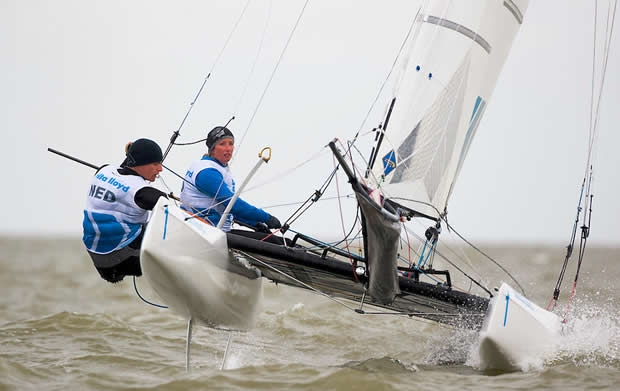
Getting to grips with the Nacra 17
While the 49er FX is something of a known quality – it is no more than a 49er with a cut-down albeit slightly stiffer rig – the Nacra 17 catamaran is causing much more headscratching for those involved.
For starters, while there have been classes in the past, such as the Tornado and 470, that have been theoretically mixed, in practice only a handful of mixed crews like Carolyn Brouwer/Seb Godefroid in the Tornado and Pete Newlands and Cathy Foster (before the 470 was split into separate male and female fleets), have ever chosen to compete in anger. With the introduction of the Nacra 17, Rio 2016 will be the first Olympic Games to have a sailing class where it is mandatory for crews to be mixed.
Then there is the boat. Catamaran design, not to mention build techniques, sails and equipment, have developed immeasurably since Rodney March penned the Tornado 46 years ago. The Nacra 17 features a state of the art hull design and its daggerboards (rather than the Tornado’s kick up centreboards) have a shallow C-shape to them, causing them to develop some vertically lift, in addition to merely preventing leeway, when lowered. For the Nacra 17 crews, many, in particular the female sailors, come to the class having had very very little previous catamaran experience. But even the old catamaran hands have very little experience with the new generation C-shaped daggerboards, that we have previously seen fitted in limited numbers in some dinghy cat classes like the A-Class and Marstom 20, etc.
Male helm or male crew?
With the first Nacra 17 Worlds this week in Den Haag, two Nacra 17 males - one a helm, another a crew and both from widely different backgrounds - gave us their views on the new Olympic catamaran. Argentinian-Swiss sailor Matías Bühler, 30 has gunned for the Olympics two times, the first occasion for Argentina and the second for Switzerland. Both times were as a 470 helm where his results included winning Hyeres in 2009. Conversely Thijs Visser, 23 from the Netherlands is an Olympic first timer but a thoroughbred cat sailor, having been sailing them since he was just 8 years old. Despite his tender years, for the last four years Visser has been Coen de Koning’s crew and he is already a past F18 World Champion (2009), came perilously close to winning it again in 2011 and was Nacra Infusion World Champ last year. However his sailing took a hammering last year when he was laid out with glandular fever. Although he has since recovered, he was laid up for three months.
To date Bühler, with Swiss former Laser Radial sailor Nathalie Brugger crewing for him (below), finished third in Hyeres and then was fifth at Kiel Week. They are one of two Swiss Nacra 17 teams.
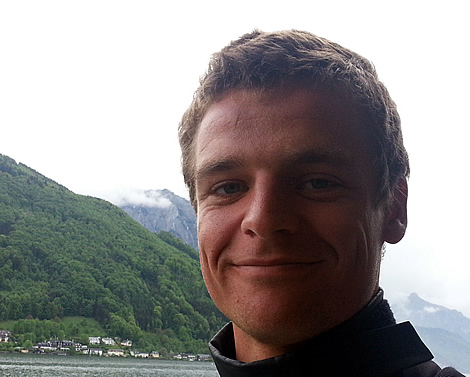
Visser (above), crewing for Beijing Yngling silver medallist helmswoman turned match racer, Mandy Mulder (above), won at Princess Sofia in Palma and was fourth at the Delta Lloyd Regatta in Medemblik. Although the Dutch Nacra 17 squad was at one point as large as 20, the squad dropped to ten this spring and the intention is to end up with three crews. One of them may well be Visser’s old helm, Coen de Koning, now crewing for Elke Delnooz.

Bühler (above) says that after 10 years in the 470 it was time for a change and he was happy to do something new. His dual nationality is thanks to his coming from Argentina, but having a Swiss grandfather enabling him to have Swiss nationality, and it is under this flag he sails today.
Snap
Both Bühler and Visser have experienced first hand the huge catalogue of teething problems that has occurred to the Nacra 17 after it appears it went into production before all its bugs could be ironed out.
With Nacra - a Dutch company these days (read more about the 17 and the company here) - the Dutch team was the first to receive boats, but was also the first to discover how profoundly unreliable they were. First to break were the carbon masts, which have since been temporarily replaced with alloy equivalents until the carbon spars can be sorted (believed to be due in time for next month’s European Championship on Lake Como).
In addition there were countless tales of boats breaking rudders and their C-foils plus even hulls failing as well.
The Swiss team got their boats mid-November. Bühler recalls: “We were breaking rudders - we had the rudder fittings moving, so we had to put a carbon plate in, but then that didn’t work.”
They didn’t break their carbon mast but Buhler admits they only used it for two days in October before he decamped back to South America where he was skippering a Soto 40 for a Chilean team over the southern hemisphere summer months. During that time the mast issues became highlighted and since returning he has been sailing with a replacement alloy spar.
“For sure there is a big difference,” Bühler says of the different spars. “Downwind we suffer a lot more from nosediving with the alloy mast. So it will be nicer for sure with the carbon mast.”
Visser attempts to put the breakages into context: “I was there for the ISAF trials in Santander and we were testing all the different types of boats. There was a big fight there between the Viper, the Nacra 16 and the Nacra 17 and in the end the Nacra 17 concept I think is better, the right concept. But the Viper was a finished boat while this was still a concept, that is why we’ve seen over this first winter quite a lot of breakage. But we are happy with the support we got from Nacra to help keep us on the water.”
Who does what?
So how did they decide who would helm and who would crew? For Visser it was straightforward – while he is able to helm, he is traditionally a catamaran crew: “I thought that if I am going to compete at this level, it would be as a crew. You have to be physically fit - that has always been my aim.”
He admits that initially when it was announced that the Nacra 17 would be for mixed crews, he wasn’t overly happy, but has since warmed to the idea. “I first experienced mixed sailing was at the trials in Santander. Then when we started the program in October on the Nacra 16s and then the 17s, it turned out that when you are sailing with a professional it doesn’t matter what their gender is. Mandy got a silver medal in Beijing and she is a really talented sailor.”
At present there is a fairly even split between men helming and crewing across the Nacra 17 fleet, with both achieving success. Visser reckons it will start to become more obvious which way is dominant in around 1 year to 18 months time. “Right now you see good helms doing really well because they are really experienced. Catamaran sailing is also a lot about starting well and getting good speed upwind and arriving at the top mark in good shape: that is about 70% of your race. And the girls are not that used to cats yet, so I reckon in 18 months or so you will see a change in that and the physical capability of the men as the crew will prove better in the end. Like in Palma we won the event and another couple of teams with male crew did well because there were rough conditions."
In the Swiss crew the decision over the roles was harder because both Bühler and Brugger were previously helms. In the end Bühler got the job and he says Brugger prefers to be a crew. “Right now it seems to be working okay, but we are both still open and if she proves to be not strong enough, we can switch. Most of us were thinking that it is better if the men crew because they are stronger, but if you see the results right now it is not like that. Male helms are doing better.”
Visser says typically the female helms also operate the Cunningham upwind and the mainsheet downwind (although typically this cleated). “The Cunningham upwind can be hard sometimes in rough conditions, but it’s still not a physically demanding job. You see that some teams with girl’s crews are sharing the mainsheet upwind.”
Kgs
The school is still out over what optimum crew weights for the Nacra 17 should be. Originally ISAF’s brief was for a feather weight 120-140kg combined crew weight.
According to Visser at present, optimum it is at the top end of this. “Normally the Nacra 17 you sail it at 140-145kg. This winter they cut the length of the daggerboards - before in normal sailing in average conditions it would be 140-143kg, but with the boards cut it is going to be less.”
Then there is the Rio factor. Given that the weather is likely to be light, Visser says he is already dieting.
Buhler also points out that the new carbon masts and their degree of stiffness is also likely to affect where the optimum combined crew weight ends up.
Then there is physiology. Bühler's crew, Nathalie Brugger has had some catamaran experience previously sailing on Dona Bertarelli’s D35 Ladycat, however making the transition to the smaller cat from the Radial has been a harder one. Whereas before she needed strength in her legs, now with all the heavy duty sail handling on the Nacra, it is will be more about upper body strength.
The gear
In terms of getting used to the foils, the game has changed slightly over the last months. To prevent the boards breaking they have been replaced with ones that have been shortened by 13cm or so. “They are not breaking anymore, but less performance. I don’t know if that was a good decision,” says Bühler, who wonders how good the Nacra 17 will be come Rio 2016, when the new Olympic catamaran is supposed to be identical supplied equipment like the Laser. As Buhler puts it: “Right now, it wouldn’t be fair.”
There is still much to be discovered about the C-shaped daggerboards Buhler maintains: “The rig and sails are ‘normal’, but you have the foils. Downwind in flat water, sometimes the boat is flying. The problem is that you have nothing [ie no lifting foil] on the rudders, so as soon as it is lifting, sometimes you can capsize backwards. We have seen that many times – you start to fly, then it is like a powerboat. But we have also had the opposite, when you move forward and then you nose dive... So we are all testing everything – sailing upwind with one daggerboard, two daggerboards, etc.”
Obviously at this stage all the crews remain on a steep learning curve, with the stand-out nations so far being France and the Netherlands. This comes as little surprise as they also happen to be among the strongest generally in dinghy cat classes, particularly in the F18.
Mixed crew
There remains some issues over the logistics of mixed crews. A few crews are in relationships/married, although one with the most potential – two time F18 World Champion Olivier Backes and France’s 470 helm for Athens and Beijing, Ingrid Petitjean, have temporarily thrown in the towel after Ingrid fell pregnant. But what if one or other of the crew is attempting to be in a relationship with someone other than their sailing partner? Clearly a lot of understanding and tolerance will be required...
“For sure it is different,” says Bühler of how he finds sailing with someone of the opposite sex. “It is something new for everyone. It is interesting. Right now, I feel pretty comfortable. Maybe with all male or all female crews there is a power thing. Maybe we still have that because I have a big character and so does she!”
From here
With the Worlds at Nacra’s base in Scheveningen, the Nacra 17s then move on to Lake Como over the end of August for their Europeans, while some will be continuing on to Santander in September for the test event for the ISAF Sailing World Championship.

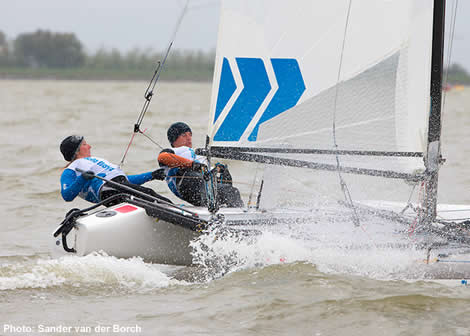
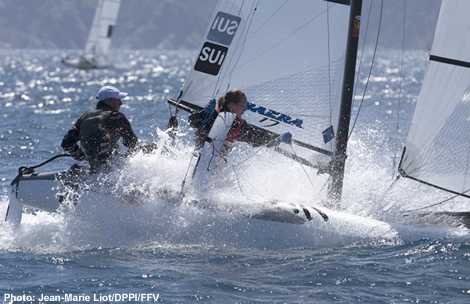
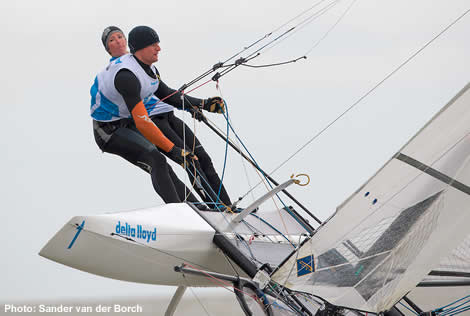
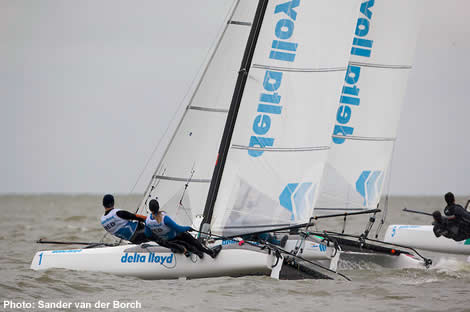







Latest Comments
Add a comment - Members log in